
Consumer Insights
Uncover trends and behaviors shaping consumer choices today
Procurement Insights
Optimize your sourcing strategy with key market data
Industry Stats
Stay ahead with the latest trends and market analysis.
Trending Now



The global rechargeable battery market was valued at USD 116.65 Billion in 2024, driven by rapid technological advancements, particularly in lithium-ion and solid-state technologies. The industry is expected to grow at a CAGR of 6.40% during the forecast period of 2025-2034 to attain a value of USD 216.92 Billion by 2034. Stricter environmental regulations and a global push for sustainability are driving industries to adopt rechargeable batteries, reducing waste and carbon footprints.
Base Year
Historical Year
Forecast Year






Value in USD Billion
2025-2034
Rechargeable Battery Market Outlook
*this image is indicative*
A rechargeable battery, or secondary battery, is a sustainable alternative to disposable batteries, utilising active materials that can be rejuvenated through charging. It produces electricity through an electrochemical reaction involving an anode, cathode, and electrolyte. These batteries are cost-effective, compact, and offer excellent runtime and longevity, which is positively impacting the growth of the rechargeable battery industry. In March 2023, Tesla launched the 4680-battery cell to improve electric vehicle performance and reduce costs. This innovative battery can cut costs per kilowatt-hour by over 50%, is 5.5 times larger than the 2170 cell, and stores five times more energy, boosting overall efficiency.
These batteries are crucial for the growth of electric vehicles, aiding in the reduction of greenhouse gas emissions. Their versatility supports a wide range of applications, from consumer electronics to industrial equipment, making them essential across various sectors. In June 2024, CATL introduced the Qilin, its third-generation CTP technology, achieving an impressive 72% volume utilization efficiency and 255 Wh/kg energy density, allowing for a range exceeding 1,000 km. This innovation follows CATL's 2019 launch of its module-less battery pack.
The demand for rechargeable battery market is driven by the rising use of portable electronic devices, the increasing need for efficient energy storage in renewable energy, and technological advancements in battery chemistry and design. Innovations like lithium-ion and solid-state batteries enhance energy density, charging speeds, and overall performance. In 2022, the Chinese government invested around USD 29 billion to bolster the semiconductor and consumer electronics industries as part of its “Made in China 2025” initiative.
Stricter environmental regulations and a global push for sustainability are driving industries to adopt rechargeable batteries, reducing waste and carbon footprints. Meanwhile, lower manufacturing costs and increased production capacity enhance accessibility. Their versatility across applications, from consumer electronics to industrial use, further strengthens their rechargeable battery market opportunities. In October 2022, Paleblue Earth was founded in Park City with the mission to replace disposable batteries with sustainable, rechargeable lithium-ion batteries. Each Paleblue battery featured a built-in USB or USB-C charging port and took less than an hour to recharge. They offered 1,000 recharges, retaining 80% of their original capacity even after that.
Rapid technological advancements, government incentives and regulations, and the growth of the consumer electronics sector are the key factors propelling the market growth.
The rechargeable battery market is increasingly driven by sustainability, as consumers and manufacturers prioritize eco-friendly solutions. Companies are adopting circular economy principles, focusing on recycling, and using sustainable materials in battery production. Regulations such as the EU’s Waste Electrical and Electronic Equipment (WEEE) Directive encourage responsible disposal and recycling of batteries. Innovations in battery chemistry aim to reduce reliance on rare materials, further supporting sustainable practices. As consumers become more environmentally conscious, the demand for batteries with lower carbon footprints is expected to grow, influencing product development and rechargeable battery market dynamics and trends. In May 2024, a new battery developed with Karlstad University and Chalmers University of Technology utilised zinc and lignin, aligning with the UN’s 2030 Sustainable Development Goals. These zinc-lignin batteries demonstrated exceptional durability and recyclability, lasting over 8,000 cycles with 80% efficiency.
Rapid technological advancements are reshaping the rechargeable battery market, particularly in lithium-ion and solid-state technologies. Innovations focus on improving energy density, charging speeds, and overall performance, making batteries more efficient for various applications, from consumer electronics to electric vehicles (EVs). Research into alternative chemistries, such as sodium-ion and lithium-sulfur batteries, aims to enhance sustainability and reduce costs. Enhanced manufacturing techniques and automation are also driving down production costs while increasing scalability. These advancements are essential for meeting the growing energy demands of modern society and will continue to play a pivotal role in market growth. In May 2024, QuantumScape announced improvements in solid-state battery technology focused on enhancing safety and boosting energy density compared to conventional lithium-ion batteries. Their batteries utilized a lithium-metal anode-free design and were capable of charging from 10% to 80% in under 15 minutes.
Government incentives and regulations are playing a crucial role in accelerating the growth of the rechargeable battery market. Across the globe, policies promoting clean energy and electric transportation are significantly boosting the adoption of battery-powered solutions. In the European Union, for example, the European Green Deal aims to make Europe climate-neutral by 2050, with a strong focus on reducing carbon emissions from transport. The EU has set a target to have 30 million electric vehicles on the road by 2030, directly increasing demand for batteries. Similarly, the United States' federal and state-level incentives, such as tax credits for electric vehicle buyers and subsidies for renewable energy storage, are pushing industries towards adopting sustainable solutions. These policies, combined with stricter environmental regulations, create a conducive environment for rechargeable battery growth across various sectors.
The growth of the consumer electronics sector is a key driver of the rechargeable battery market. The increasing demand for mobile phones, laptops, tablets, wearables, and other portable devices has led to a greater need for compact, efficient, and high-capacity rechargeable batteries. Advancements in battery technology, such as lithium-ion and solid-state batteries, are essential to meet the energy needs of these devices while maintaining size and weight constraints. Additionally, the rise of wearable technologies, including smartwatches and fitness trackers, has further expanded the market for small yet powerful rechargeable batteries. As consumer expectations for longer battery life and faster charging times increase, manufacturers are focusing on improving battery efficiency and longevity. This demand for advanced, portable energy solutions is propelling innovation and production in the rechargeable battery market, making it a crucial component in the consumer electronics industry’s ongoing growth.
As renewable energy sources like solar and wind become more prevalent, the need for effective energy storage solutions is rising, significantly influencing the market. Batteries are essential for storing energy generated from renewable sources for later use, ensuring a stable energy supply. Technologies such as grid-scale energy storage systems are gaining traction, utilizing rechargeable batteries to balance supply and demand. This trend is backed by government initiatives that advocate for the integration of renewable energy and storage solutions. With the increase in investments in renewable energy infrastructure, the demand for the rechargeable battery market is anticipated to grow. In June 2023, Panasonic launched its next-generation solar energy battery storage system, the EverVolt™ 2.0. Based in Newark, NJ, the company announced this latest innovation as part of its comprehensive solar energy portfolio of Total Home Energy Solution offerings.
The rechargeable battery market faces several key restraints, including raw material supply chain issues, high manufacturing costs, and stringent environmental regulations. Limitations in battery performance and inadequate recycling infrastructure further complicate the landscape.
Additionally, competition from alternative technologies and varying consumer awareness hinder adoption. Market saturation in consumer electronics also poses challenges, leading to price wars and reduced profit margins, ultimately stifling innovation and investment in the sector.
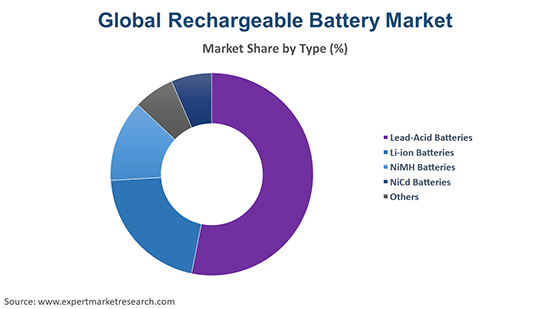
Read more about this report - REQUEST FREE SAMPLE COPY IN PDF
The EMR’s report titled “Rechargeable Battery Market Report and Forecast 2025-2034” offers a detailed analysis of the market based on the following segments:
Market Breakup by Type
Market Breakup by Capacity
Market Breakup by Application
Market Breakup by Region
Market Analysis by Type
Lead-acid batteries are cost-effective, making them an economical choice for various applications, supported by a mature manufacturing and recycling infrastructure. Capable of delivering high surge currents, they excel in applications requiring quick power bursts, like engine starts. They also demonstrate consistent performance across various temperatures and are highly recyclable, which lowers environmental impact and contributes to the rechargeable battery market revenue. In June 2021, three companies in China launched graphene-enhanced lead-acid batteries, claiming that graphene improved battery performance. Tianneng Battery introduced its TNEH Series, which featured a 20% longer cycle life and a 5% capacity increase at low temperatures.
Lithium-ion batteries offer a greater energy density compared to lead-acid batteries, facilitating increased power storage in a more compact and lightweight design. This trend in the rechargeable battery market is driven by their longer lifespans, allowing for more charge and discharge cycles, thereby improving cost-effectiveness. Additionally, they charge faster, minimizing downtime. With a lower self-discharge rate, they retain charge longer, making them suitable for infrequent use, and they perform well across various temperatures, making them ideal for high-performance applications like electric vehicles. In July 2022, Toshiba launched its 20Ah-HP lithium-ion rechargeable battery cell as part of its SCiB product line. This new cell aims to enhance performance and efficiency in various applications, reflecting Toshiba's commitment to innovation in battery technology.
Market Analysis by Application
Rechargeable batteries, particularly lithium-ion variants, promote sustainability by lowering greenhouse gas emissions and supporting the shift to electric vehicles (EVs), which further boosts the rechargeable battery industry revenue. They also enhance cost efficiency by lowering fuel expenses and minimizing the frequency of battery replacements. With high energy density, they enable longer driving ranges, while advancements in technology allow for faster charging times and consistent performance across varying conditions, ensuring reliable vehicle operation. In August 2023, Contemporary Amperex Technology Co. Limited (CATL) launched a 'superfast charging' battery, claiming it can deliver a driving range of about 400 km with just a 10-minute charge. This LFP battery also offers over 700 km on a full charge.
Rechargeable batteries provide critical energy security for military operations, enhancing independence from fossil fuels. Their lightweight design improves the portability of equipment, making them suitable for diverse mobile applications. With extended cycle lives, they proved to be cost-effective for prolonged military applications. Furthermore, high-capacity batteries enabled advanced technologies such as drones and communication devices, enhancing operational efficiency while supporting sustainability objectives to reduce environmental impact, thereby driving rechargeable battery demand growth. In June 2024, GM Defense announced it would supply battery storage for military platforms. The General Motors subsidiary provided commercial battery electric technology based on the Ultium Platform to the University of Texas at Arlington (UTA), aiming to utilize domestically sourced energy storage for future military applications.
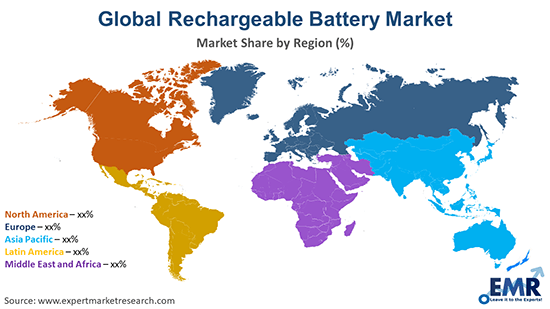
Read more about this report - REQUEST FREE SAMPLE COPY IN PDF
Europe Rechargeable Battery Market Analysis
Europe is witnessing a notable increase in the rechargeable battery demand, particularly in Germany, Italy, and France. Rechargeable batteries support electric vehicle adoption and cleaner transportation through government incentives, while also driving economic growth by creating jobs in manufacturing, research, and recycling sectors. A new European law mandates the collection, reuse, and recycling of batteries, ensuring low carbon footprints and reduced reliance on non-EU materials. This regulation supports a circular economy, enhances strategic autonomy, and sets standards for electric vehicles and other rechargeable technologies by 2025.
North America Rechargeable Battery Market Trends
The North American rechargeable battery market value is poised for significant growth, driven by leading brands like Tesla, Inc., General Motors (GM) and A123 Systems. Rechargeable batteries support electric vehicle adoption, promoting cleaner transportation through government incentives and infrastructure investments. In 2023, the Government of Canada revealed major investments to bolster the electric vehicle (EV) market, setting a goal for all light-duty car and truck sales to be zero-emission by 2035.
Asia Pacific Rechargeable Battery Market Insights
In China, brands such as BAK Battery, Tianjin Lishen Battery Joint-Stock Co., Ltd. and Sinopoly Battery highlight the growing rechargeable battery market share in the Asia-Pacific region. In May 2024, Gotion introduced its latest innovations at the 13th technology conference in Hefei, including its first all-solid-state battery and products like the ultra-fast charging 'G-Curent' and 'Stellary Battery'.
Latin America Rechargeable Battery Market Analysis
Key markets in the region include Brazil, Mexico, and Argentina, where there is significant demand for rechargeable battery market. Rechargeable batteries support renewable energy integration and play a vital role in energy storage, while also driving economic growth through job creation in manufacturing and recycling sectors. In March 2024, BYD launched the BYD DOLPHIN MINI in Brazil and Mexico. This pure electric vehicle, featuring a compact design and nimble handling, quickly became popular in the local new energy automobile market.
Middle East and Africa Rechargeable Battery Market Driving Factors
The African rechargeable battery market is experiencing growth, particularly in Egypt, Ethiopia, and Morocco. Rechargeable batteries support renewable energy storage, boost economic growth through job creation, and enhance energy access for homes and businesses, reducing reliance on fossil fuels. In June 2023, Davis & Shirtliff introduced cost-effective solar rechargeable batteries in Ghana, aimed at improving energy access for off-grid communities.
Innovative startups in the rechargeable battery market are making considerable progress by introducing disruptive technologies, such as solid-state batteries, which enhance energy density and safety. These companies prioritize cost reduction through sustainable practices, improve product customization, and target niche markets. They also support rapid development cycles, generate employment, and advocate for sustainability. Partnerships with established companies further enhance their influence, increasing consumer awareness and advancing battery technology.
ReCharge AI (2024): This startup integrates AI with battery management systems to optimize charging cycles and enhance lifespan. ReCharge AI's smart batteries can learn usage patterns, providing users with tailored recommendations and significantly improving energy efficiency for both consumers and industries.
FlexiPower Systems (2024): FlexiPower Systems is developing flexible, lightweight batteries designed for wearables and IoT devices. Their innovative approach combines thin-film technology with high-capacity energy storage, enabling new applications in health tech and smart clothing, pushing the boundaries of portable energy.
Key market players prioritise innovation and sustainability, creating high-performance lithium-ion, nickel-based, and lead-acid batteries. Renowned for their reliability, these products are vital for applications such as backup power, electric vehicles, and grid energy storage. Committed to research and development, they invest in new technologies to improve performance and reduce environmental impact, with manufacturing facilities located throughout Europe, North America, and Asia to cater to a global market.
Based in Lyon Station, Pennsylvania, East Penn Manufacturing, established in 1946, is a leading producer of lead-acid batteries. The company emphasizes quality, sustainability, and recycling, serving various markets, including automotive and renewable energy, while striving to minimize environmental impact.
Founded in 2000 and headquartered in Reading, Pennsylvania, EnerSys Advanced Systems specializes in advanced battery solutions for industrial applications. Their high-performance lead-acid and lithium-ion batteries cater to critical sectors such as telecommunications and aerospace, focusing on efficiency and reliability.
Established in 1947 and headquartered in Gurgaon, India, Exide Industries is a major battery manufacturer specializing in lead-acid batteries for automotive and industrial use. With a strong emphasis on R&D, Exide aims to innovate and expand its offerings to meet increasing energy demands.
Founded in 1947 and based in Seoul, South Korea, LG Chem is a leader in lithium-ion battery technology for electric vehicles and energy storage. The company prioritizes innovation and sustainability, developing high-capacity, long-life batteries to support the transition to cleaner energy solutions globally.
*Please note that this is only a partial list; the complete list of key players is available in the full report. Additionally, the list of key players can be customized to better suit your needs.*
Other market key players in rechargeable battery market report are Saft Groupe SA, and Samsung SDI Co., Ltd among others.
*While we strive to always give you current and accurate information, the numbers depicted on the website are indicative and may differ from the actual numbers in the main report. At Expert Market Research, we aim to bring you the latest insights and trends in the market. Using our analyses and forecasts, stakeholders can understand the market dynamics, navigate challenges, and capitalize on opportunities to make data-driven strategic decisions.*
Get in touch with us for a customized solution tailored to your unique requirements and save upto 35%!
The market is assessed to grow at a CAGR of 6.40% between 2025 and 2034.
The major drivers of the market include the growing demand for portable electronic devices, rising disposable incomes, and the surging popularity of wearable smart devices.
The growing adoption of electric vehicles driven by the increasing eco-consciousness and the development of innovative variant of the product are the major trends guiding the growth of the market.
The major regions in the market are Latin America, North America, the Middle East and Africa, Europe, and the Asia Pacific.
The various battery types considered in the market report are lead-acid batteries, li-ion batteries, NiMH batteries, and NiCd batteries, among others.
The significant capacities of the product in the market are 150 - 1000 mAh, 1300 - 2700 mAh, 3000 - 4000 mAh, 4000 - 6000 mAh, 6000 - 10000 mAh, and more than 10000 mAh, among others.
Consumer electronics, industrial applications, automobile applications, and defence, among others, are the major applications of rechargeable battery.
The leading players in the market are East Penn Manufacturing Company, EnerSys Advanced Systems Inc., Exide Industries Ltd, LG Chem, Saft Groupe SA, and Samsung SDI Co., Ltd, among others.
In 2024, the rechargeable battery market reached an approximate value of USD 116.65 Billion.
The market is estimated to witness healthy growth in the forecast period of 2025-2034 to reach a value of around USD 216.92 Billion by 2034.
Explore our key highlights of the report and gain a concise overview of key findings, trends, and actionable insights that will empower your strategic decisions.
| REPORT FEATURES | DETAILS |
| Base Year | 2024 |
| Historical Period | 2018-2024 |
| Forecast Period | 2025-2034 |
| Scope of the Report |
Historical and Forecast Trends, Industry Drivers and Constraints, Historical and Forecast Market Analysis by Segment:
|
| Breakup by Type |
|
| Breakup by Capacity |
|
| Breakup by Application |
|
| Breakup by Region |
|
| Market Dynamics |
|
| Competitive Landscape |
|
| Companies Covered |
|
| Report Price and Purchase Option | Explore our purchase options that are best suited to your resources and industry needs. |
| Delivery Format | Delivered as an attached PDF and Excel through email, with an option of receiving an editable PPT, according to the purchase option. |
Single User License
One User
USD 3,999
USD 3,599
tax inclusive*
Datasheet
One User
USD 2,499
USD 2,249
tax inclusive*
Five User License
Five User
USD 4,999
USD 4,249
tax inclusive*
Corporate License
Unlimited Users
USD 5,999
USD 5,099
tax inclusive*
*Please note that the prices mentioned below are starting prices for each bundle type. Kindly contact our team for further details.*
Flash Bundle
Small Business Bundle
Growth Bundle
Enterprise Bundle
*Please note that the prices mentioned below are starting prices for each bundle type. Kindly contact our team for further details.*
Flash Bundle
Number of Reports: 3
20%
tax inclusive*
Small Business Bundle
Number of Reports: 5
25%
tax inclusive*
Growth Bundle
Number of Reports: 8
30%
tax inclusive*
Enterprise Bundle
Number of Reports: 10
35%
tax inclusive*
How To Order
Our step-by-step guide will help you select, purchase, and access your reports swiftly, ensuring you get the information that drives your decisions, right when you need it.

Select License Type
Choose the right license for your needs and access rights.

Click on ‘Buy Now’
Add the report to your cart with one click and proceed to register.

Select Mode of Payment
Choose a payment option for a secure checkout. You will be redirected accordingly.
Gain insights to stay ahead and seize opportunities.
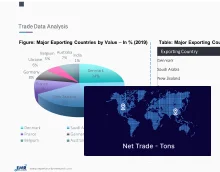
Get insights & trends for a competitive edge.
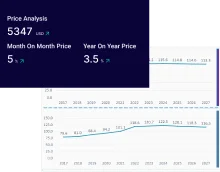
Track prices with detailed trend reports.
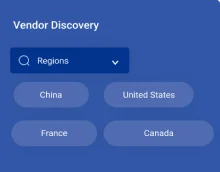
Analyse trade data for supply chain insights.

Leverage cost reports for smart savings
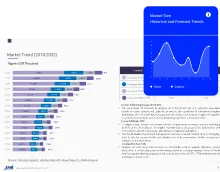
Enhance supply chain with partnerships.
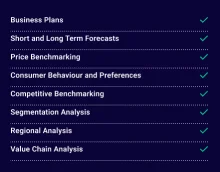
Connect For More Information
Our expert team of analysts will offer full support and resolve any queries regarding the report, before and after the purchase.
Our expert team of analysts will offer full support and resolve any queries regarding the report, before and after the purchase.
We employ meticulous research methods, blending advanced analytics and expert insights to deliver accurate, actionable industry intelligence, staying ahead of competitors.
Our skilled analysts offer unparalleled competitive advantage with detailed insights on current and emerging markets, ensuring your strategic edge.
We offer an in-depth yet simplified presentation of industry insights and analysis to meet your specific requirements effectively.



Australia
63 Fiona Drive, Tamworth, NSW
+61-448-061-727
India
C130 Sector 2 Noida, Uttar Pradesh 201301
+91-723-689-1189
Philippines
40th Floor, PBCom Tower, 6795 Ayala Avenue Cor V.A Rufino St. Makati City,1226.
+63-287-899-028, +63-967-048-3306
United Kingdom
6 Gardner Place, Becketts Close, Feltham TW14 0BX, Greater London
+44-753-713-2163
United States
30 North Gould Street, Sheridan, WY 82801
+1-415-325-5166
Vietnam
193/26/4 St.no.6, Ward Binh Hung Hoa, Binh Tan District, Ho Chi Minh City
+84-865-399-124
United States (Head Office)
30 North Gould Street, Sheridan, WY 82801
+1-415-325-5166
Australia
63 Fiona Drive, Tamworth, NSW
+61-448-061-727
India
C130 Sector 2 Noida, Uttar Pradesh 201301
+91-723-689-1189
Philippines
40th Floor, PBCom Tower, 6795 Ayala Avenue Cor V.A Rufino St. Makati City, 1226.
+63-287-899-028, +63-967-048-3306
United Kingdom
6 Gardner Place, Becketts Close, Feltham TW14 0BX, Greater London
+44-753-713-2163
Vietnam
193/26/4 St.no.6, Ward Binh Hung Hoa, Binh Tan District, Ho Chi Minh City
+84-865-399-124
Share